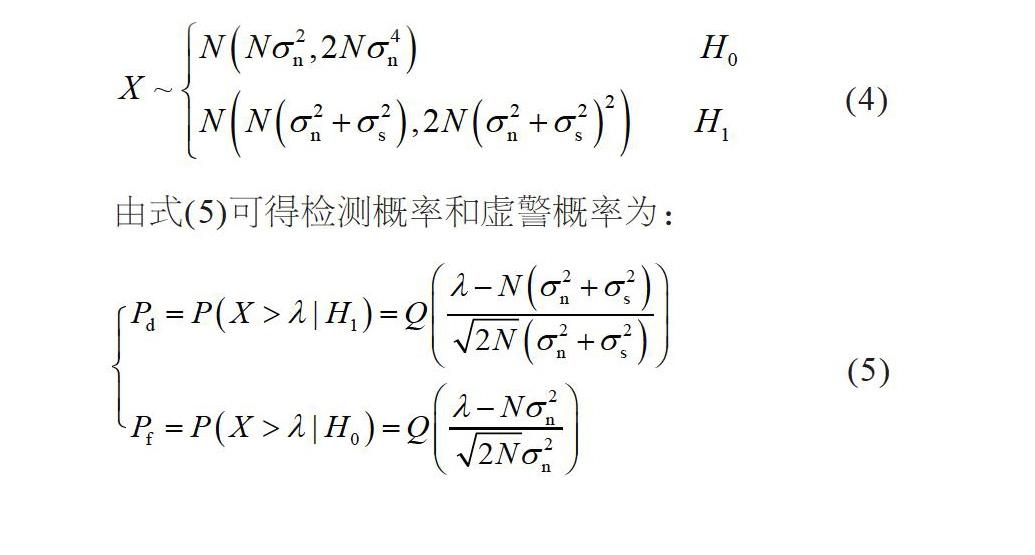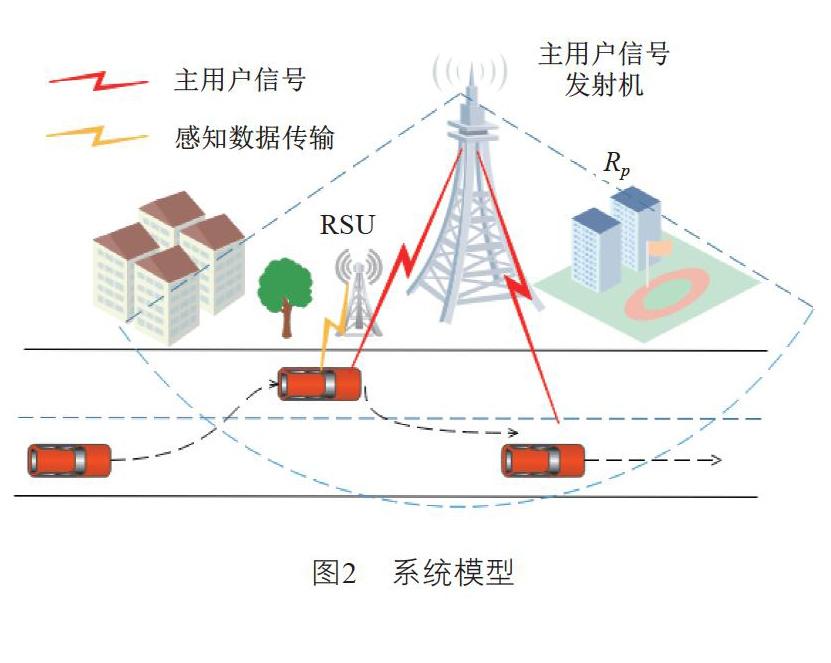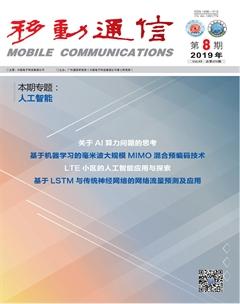一种门限自适应的认知车联网频谱感知算法
林惠娇 胡斌杰 齐嘉杰



【摘 要】能量檢测中门限值的设定直接影响频谱感知的检测性能。认知车辆的移动性导致了车载通信环境的动态变化,提出了一种基于FCM的动态双门限能量检测算法,门限值随环境自适应变化,双门限检测算法消除了噪声不确定的影响。仿真结果表明,所提算法在车载通信场景中具有很好的自适应性,检测性能更好。
【关键词】认知车联网;频谱感知;FCM;门限值
doi:10.3969/j.issn.1006-1010.2019.08.014 中图分类号:TN929.5
文献标志码:A 文章编号:1006-1010(2019)08-0077-06
引用格式:林惠娇,胡斌杰,齐嘉杰. 一种门限自适应的认知车联网频谱感知算法[J]. 移动通信, 2019,43(8): 77-82.
[Abstract] The setting of the threshold value in the energy detection algorithm directly affects the detection performance of the spectrum sensing. The mobility of cognitive vehicles causes dynamic changes in the vehicle communication environment. Hence a dynamic double-threshold energy detection algorithm based on FCM is proposed in this paper, where the threshold value changes adaptively with the environment and the double-threshold detection algorithm eliminates the influence of noise uncertainty. Simulation results show that the proposed algorithm has good adaptability and better detection performance in vehicle communication scenarios.
CR-VANETs; spectrum sensing; FCM; threshold
1 引言
随着科技的发展,人们对出行的安全性、舒适性的要求也越来越高。智能交通系统应运而生,它提高了道路安全性和交通运输效率[1]。车载自组织网络是智能交通系统的重要组成部分。随着人们对道路安全业务和车载娱乐服务的要求越来越高,各类车载通信业务爆发式增长,导致用于车载自组网通信的无线电频谱资源的匮乏[2]。为了解决这一问题,将认知无线电技术引入到车载自组织网络中,认知车联网(Cognitive Radio enabled Vehicular Ad-hoc Networks, CR-VANETs)应运而生[3]。认知无线电技术是一种新型的频谱共享技术,它可以机会性地接入授权频段中未充分利用的部分,为车载通信提供额外的频谱资源。在认知无线电网络中,主用户是对某特定频段拥有较高优先权的用户,未被授权的用户被定义为次用户,认知车联网中具有认知功能的车辆即为次用户,也称为认知车辆。频谱感知技术是认知无线电系统中实现授权频谱资源再利用的首要环节。因此,认知车联网中频谱感知技术的研究至关重要。
现有的CR-VANETs频谱感知技术有能量检测、循环平稳特征检测、匹配滤波器检测等[4]。针对车联网的复杂通信环境,文献[5]提出使用路侧单元连续感知预选的信道群,先通过快速的能量感知,粗略估计信道是否可用,然后在移动车载终端,结合路侧单元的指示,针对筛选后的信道集进行精确感知的两阶段频谱感知方案。文献[6]提出了一种基于最佳阈值的能量检测方案,基于漏检概率和虚警概率之间的权衡来得出最佳阈值,定义自适应阈值因子,提高低信噪比环境下的检测概率。文献[7]提出了基于循环平稳改进的能量检测,可以提高在低信噪比环境中主用户的检测概率,易于实现且降低了复杂度,文中采用信号的周期平稳性降低噪声对检测性能的影响。文献[8]提出一种基于离散小波变换的高精度、低复杂度的自适应阈值能量检测算法。
由于能量检测实现简单,计算复杂度低且检测速度快,因此,本文应用能量检测算法进行频谱感知,并在此基础上进行改进,提出了一种基于FCM的动态双门限能量检测算法,利用FCM算法在动态变化的车载通信环境中获取自适应门限,引入双门限克服噪声不确定性对频谱感知的不良影响。
2 系统模型
本文针对现有认知车联网中频谱感知技术存在的问题,提出了一种基于FCM获取自适应双门限值的能量检测算法。所提算法在认知车辆不断移动的通信环境中,能够随着环境的变化自适应获取门限值,保证频谱感知的性能不受影响,同时引入了双门限检测,克服了噪声不确定性的影响。仿真结果表明,所提算法在车联网场景下具有较好的检测性能。
参考文献:
[1] Daniel A, Paul A, Ahmad A, et al. Cooperative Intelligence of Vehicles for Intelligent Transportation Systems (ITS)[J]. Wireless Personal Communications, 2016,87(2): 461-484.
[2] Joy E, Sijing Z, Enjie L, et al. Cognitive radio-enabled Internet of Vehicles: a cooperative spectrum sensing and allocation for vehicular communication[J]. IET Networks, 2018,7(4): 190-199.
[3] Singh K, Rawat P, Bonnin J M. Cognitive radio for vehicular ad hoc networks (CR-VANETs): approaches and challenges[J]. EURASIP Journal on Wireless Communications and Networking, 2014(1): 49-61.
[4] Lim M Y, Chang Y C, Alias M Y, et al. Cognitive radio network in vehicular ad-hoc network (VANET): A survey[J]. Cogent Engineering, 2016,3(1): 1-19.
[5] Wang X Y, Ho P H. A Novel Sensing Coordination Framework for CR-VANETs[J]. IEEE Transactions on Vehicular Technology, 2010,59(4): 1936-1948.
[6] Ahmed S B, Kozal, Merabti M, et al. An improved energy detection scheme for cognitive radio networks in low SNR region[C]//IEEE Symposium on Computers and Communications. Cappadocia, IEEE, 2012: 684-689.
[7] Han D, Liu H. An Energy Detection Based on Cyclostationary[C]//International Conference on Wireless Communications. Wuhan, IEEE, 2011: 1-4.
[8] Qin Z, Wang N, Gao Y, et al. Adaptive Threshold for Energy Detector Based on Discrete Wavelet Packet Transform[C]//Wireless Telecommunications Symposium. London, IEEE, 2012: 1-5.
[9] Zhang W, Mallik R, Letaief K. Optimization of cooperative spectrum sensing with energy detection in cognitive radio networks[J]. IEEE Transactions on Wireless Communications, 2009,8(12): 5761-5766.
[10] Lopez-Benitez M, Casadevall F. Improved energy detection spectrum sensing for cognitive radio[J]. IET Communications, 2012,6(8): 785-796.
[11] Krinidis S, Chatzis V. A Robust Fuzzy Local Information C-Means Clustering Algorithm[J]. IEEE Transactions on Image Processing, 2010,19(5): 1328-1337.
[12] Zhu S, Guo C, Feng C, et al. User correlation and double threshold based cooperative spectrum sensing in dense cognitive vehicular networks[C]//International Symposium on Wireless Communication Systems. Poznan, IEEE, 2016: 281-285.

